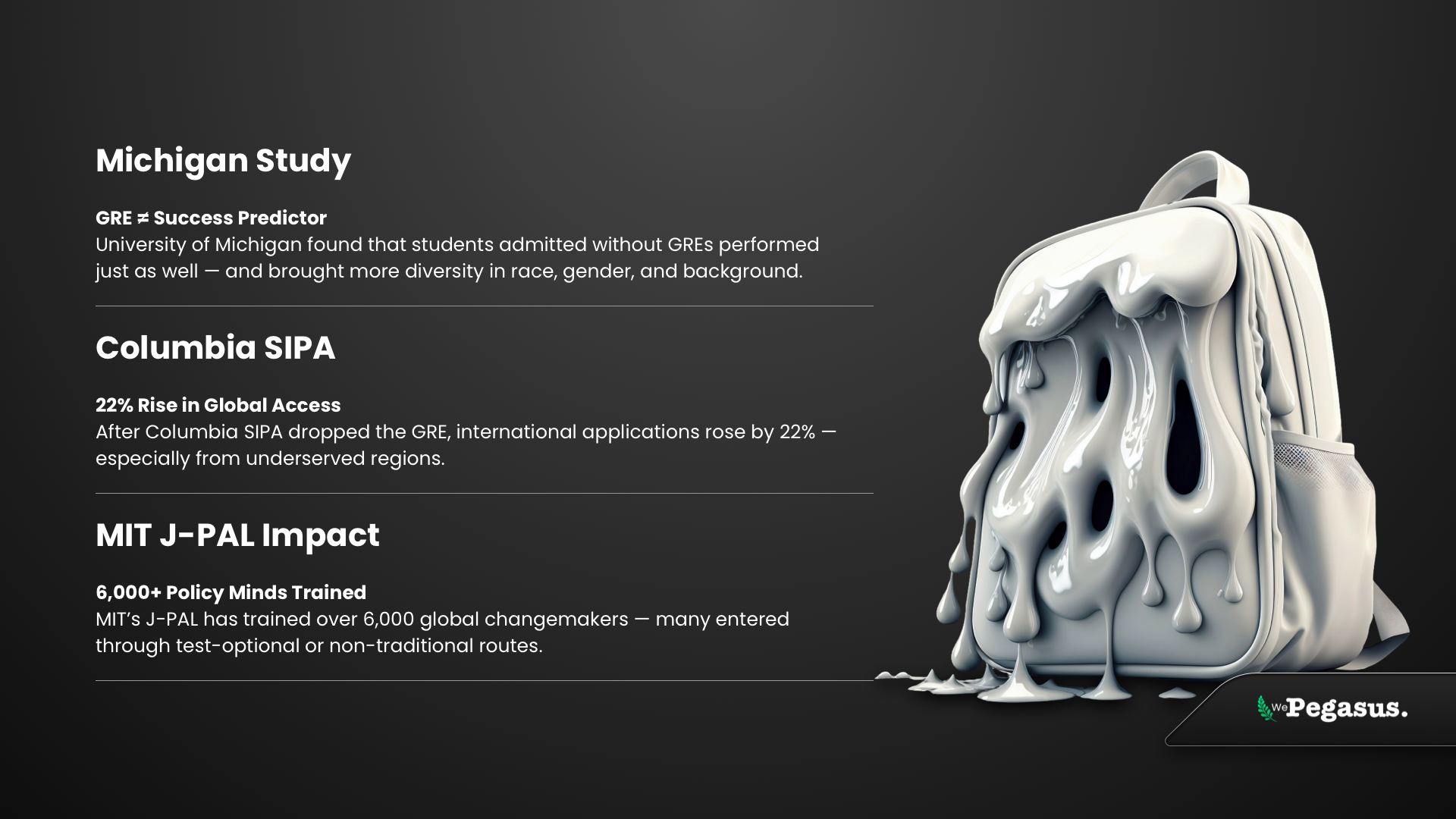It’s 1994.
A young woman from France arrives at the Massachusetts Institute of Technology with a head full of questions and a heart burning with purpose. She isn’t sure if she belongs — her English is patchy, she’s not from a top American college, and the weight of an Ivy League classroom feels heavier than the Boston snow.

That woman was Esther Duflo. And within 25 years, she would go on to win the Nobel Prize in Economics.
But imagine for a moment that she hadn’t made it through the filters. That she had been turned away by a computer screen scanning her GRE score, or a gatekeeping panel prioritizing high GMAT percentile holders over lived experiences. Would we still have the groundbreaking insights in development economics that Esther helped pioneer?
This isn’t just her story. It’s the story of a shifting academic world — one where the pillars of standardized testing are slowly crumbling, and not without reason.
The GRE/GMAT Era — What Were We Even Measuring?
For decades, the GRE (Graduate Record Examination) and GMAT (Graduate Management Admission Test) were seen as intellectual litmus tests. For business schools, policy programs, and even data science tracks, these scores promised to distill brilliance into a three-digit number.
But there’s a growing crack in that promise.
According to data published by the ETS (Educational Testing Service), fewer than 1.2 million GRE tests were taken globally in 2023 — a 15% drop from 2019. GMAT saw an even steeper decline, with applications for top 50 B-schools down by 13% compared to pre-pandemic years.
Meanwhile, top schools started asking the same uncomfortable questions students have been asking for years:
- Do these scores actually predict success?
- Are we filtering out future changemakers just because they don’t test well?
- Are we privileging those who can afford $200-an-hour coaching over raw potential?

Image Source: Pexels
In 2020, the pandemic hit — and with it came a wave of test-optional policies. What was meant to be a temporary shift has slowly become the new normal.
MIT, Harvard, Stanford: When Giants Begin to Whisper
Let’s come back to MIT — Esther’s alma mater.
In 2023, MIT’s School of Engineering quietly dropped the GRE requirement for its graduate programs. Not a press release. Not a parade. Just a quiet edit on the application page. By 2024, almost 70% of its graduate programs had made GRE optional or completely waived it.
Harvard Kennedy School, once a bastion of GRE elitism, followed suit. Several of its master’s programs, including the MPP and MPA-ID, dropped standardized test requirements.
Stanford, Berkeley, Columbia SIPA, NYU, Yale School of Management — the list reads like a who’s who of global academia. Over 400 top-tier programs in the U.S. have either gone test-optional or eliminated the requirement altogether.
Why?
Because data began to speak louder than tradition.
In a 2022 study published by the University of California, researchers found no significant correlation between GRE scores and academic success or post-graduate performance in STEM graduate programs. Even worse, the scores often negatively impacted diversity, acting as unintentional filters against first-gen, low-income, and minority students.
“I Was Never the Best Test-Taker” — Duflo’s Take on Merit
Esther Duflo once said in an interview with The Guardian:
“What makes you a good economist isn’t your ability to solve a math problem quickly. It’s your ability to stay with a problem long enough to understand what matters.”
If that isn’t a direct challenge to the very idea of GRE/GMAT dominance, I don’t know what is.
Duflo’s journey wasn’t born out of high scores. It was born out of stubborn curiosity, fieldwork in Indian villages, and partnerships with those on the margins. Her co-founding of the Abdul Latif Jameel Poverty Action Lab (J-PAL) at MIT reshaped how we think about poverty — using randomized control trials, storytelling, and ground-level empathy.
Imagine if someone had said her math section percentile wasn’t high enough. Imagine if MIT had turned her away.
Now multiply that by the thousands of students rejected each year based on test scores that fail to capture real-life potential.
But Wait — Are We Just Letting Everyone In?
The natural counterpoint to test-free admissions is this: are we lowering the bar?
Not quite.
What we’re witnessing is not a dilution of standards, but a redefinition of merit. Schools aren’t tossing out applications blindly. They’re investing in holistic reviews — analyzing resumes, recommendation letters, statement of purposes, portfolios, interviews, and in some cases, even personal essays with greater care.
At MIT Sloan School of Management, for example, test-optional doesn’t mean less selective. Instead, it means that your work with a social enterprise in rural Gujarat might weigh as much as your quant score. That your five years building a micro-lending app for women might mean more than acing a geometry problem under pressure.
This shift is creating room for a different kind of intelligence — emotional, contextual, entrepreneurial.
Numbers That Tell a Better Story
Let’s look at a few hard stats:

- A study from the University of Michigan found that students admitted without GREs performed equally well academically and were more diverse in race, gender, and socioeconomic background.
- At Columbia SIPA, which dropped the GRE for multiple years, international applications increased by 22%, particularly from underserved geographies.
- MIT’s J-PAL has directly trained over 6,000+ global policymakers and economists — many of whom entered through unconventional paths or were test-optional admits.
These are not anomalies. They’re indicators of a system slowly realigning with reality.
What Does This Mean for the Next Esther Duflo?
Somewhere in India, Nigeria, or Colombia, there’s a young girl who just discovered her love for economics.
She doesn’t have access to GRE coaching. Her English isn’t polished. But she’s collecting data on how floods affect school attendance in her village. She’s asking the kind of questions Duflo would ask. And now, she may just have a shot — not because her score is high, but because her story is powerful.
This is what happens when you make space for humans in human potential.
Conclusion: Dismantling the Scoreboard, Rebuilding the Lens
The story of Esther Duflo isn’t a story of tests passed. It’s a story of systems questioned, data reimagined, and poverty understood not from spreadsheets but from soil and sweat.
As top universities start moving away from rigid test requirements, they’re echoing the same values that Duflo represents: curiosity over conformity, effort over entitlement, insight over intellect.
It’s not about dropping standards. It’s about lifting the right people.
So maybe the real test isn’t a GRE at all — maybe it’s the courage to change what we measure, and in turn, who we become.
GLOSSARY:
GRE (Graduate Record Examination):
A standardized test required for admission to many graduate schools in the United States and other countries. It measures verbal reasoning, quantitative reasoning, and analytical writing.
GMAT (Graduate Management Admission Test):
A standardized exam used primarily for MBA and other business-related graduate programs, measuring reasoning and analytical skills.
Holistic Review:
An admissions approach that evaluates the whole applicant — including experience, motivation, essays, interviews — rather than just test scores and grades.
Test-Optional:
A policy allowing applicants to choose whether or not to submit standardized test scores with their application.
Test-Free:
Also known as “test-blind” — a policy where schools do not consider standardized test scores at all, even if submitted.
J-PAL (Abdul Latif Jameel Poverty Action Lab):
A global research center co-founded by Esther Duflo that uses randomized evaluations to answer critical policy questions in poverty reduction.
Nobel Prize in Economics (Sveriges Riksbank Prize):
One of the most prestigious awards in economics, officially named the Sveriges Riksbank Prize in Economic Sciences in Memory of Alfred Nobel.
SOURCES:
- Educational Testing Service (ETS) – GRE Test Trends and Annual Statistics https://www.ets.org
- Graduate Management Admission Council (GMAC) – GMAT Trends Report https://www.gmac.com
- MIT News – On MIT Departments Dropping GRE Requirements https://news.mit.edu
- Harvard Kennedy School Admissions – Test Policy Updates https://www.hks.harvard.edu/admissions
- Stanford Graduate Admissions – Test-Optional Policies https://gradadmissions.stanford.edu
- J-PAL Official Website – Esther Duflo’s Research and Policy Work https://www.povertyactionlab.org
- The Guardian – Interview with Esther Duflo, “The Economist Who Wants to Save the World” https://www.theguardian.com
- University of California Report on GRE Validity Published study: “The Limited Predictive Validity of the GRE for Graduate Student Success” https://www.ucop.edu
- Columbia SIPA Admissions Blog – Trends in Test-Optional Applications https://sipa.columbia.edu


